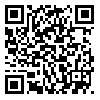Volume 15, Issue 5 (2013)
JAST 2013, 15(5): 901-910 |
Back to browse issues page
Download citation:
BibTeX | RIS | EndNote | Medlars | ProCite | Reference Manager | RefWorks
Send citation to:



BibTeX | RIS | EndNote | Medlars | ProCite | Reference Manager | RefWorks
Send citation to:
Dadkhah A. Effect of Salinity on Carbon Isotope Discrimination of Shoot and Root of Four Sugar Beet (Beta vulgaris L.) Cultivars. JAST 2013; 15 (5) :901-910
URL: http://jast.modares.ac.ir/article-23-10456-en.html
URL: http://jast.modares.ac.ir/article-23-10456-en.html
Department of Agronomy, Faculty of Agriculture, Ferdowsi University of Mashhad, Islamic Republic of
Iran.
Abstract: (6171 Views)
A factorial pot experiment based on randomized complete blocks design with four replications was carried out in order to evaluate salt tolerance of four sugar beet cultivars including Madison (British origin) and three Iranian cultivars (7233-P12, 7233-P21 and 7233-P29) using carbon isotope discrimination (Δ). Plants were grown in sand culture medium in greenhouse conditions. Sugar beet cultivars were irrigated with saline water (tap water as control, 50, 150, 250 and 350 mM of NaCl and CaCl2 in 5: 1 molar ratio) from 4-leaf stage for 16 weeks. Carbon isotope discrimination significantly decreased with increasing salinity. Significant differences of Δ between shoot and root were observed in all cultivars and all levels of salinity. Madison cv. showed lower Δ in shoot and root than the other three cultivars at all levels of salinity except the control, but cv. 7233-P29 had significantly higher Δ values at saline conditions of 150 mM and above. Although the regression of Δ and Ci/Ca was positive, the slope of regression line was different from the pattern predicted by theory, indicating an underestimation of Δ in these samples. Relatively higher 13C (lower Δ) was found in root as compared with shoots.
Keywords: Carbon/ Nitrogen ratio, Photosynthesis, Salt stress, Stomatal conductance, Water
use efficiency
Article Type: Research Paper |
Subject:
Agronomy
Received: 2011/10/10 | Accepted: 2012/10/10 | Published: 2013/09/1
Received: 2011/10/10 | Accepted: 2012/10/10 | Published: 2013/09/1
| Rights and permissions | |
 |
This work is licensed under a Creative Commons Attribution-NonCommercial 4.0 International License. |







